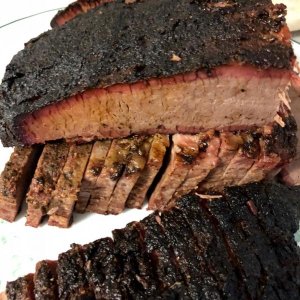SergeantSmoke
Got Wood.
Some how I have found a way to get myself into a funk of dry meat lately and I am wondering if the techniques I've recently picked up are what's causing the problems.
Backing up a few months I finally got a brisket to turn out right. Took 5 attempts but the first 3 I'll admit I had zero idea what I was doing. Brisket 4 was decent but 5 was close to perfection in my opinion.
Brisket 6 came with a dry flat. This is when I started spraying my meats every 45-60 minutes. I also started to cut the foil open after the meat was done to release some heat. After 15-20 minutes it was tossed in a cooler with more foil for about an hour.
Yesterdays pork butt was done the same way. This time I checked the bone as soon as I cut the foil open and it was easily moved and I left it in having piece of mind the butt was going to pull perfect based on that and probing perfectly every where. After sitting in the cooler for about 1.5 hours I took it out and went to pull the bone. Took more effort then I wanted and it was obvious the butt has shrunk considerably. I took a few tastes and sure enough it was sort of dry.
What am I doing wrong here? It seems like the spritzing and cutting the foil open is causing the problems. Has anyone else experienced this? Or is there something else I should be doing? None of these meats were injected either by the way. Everything before this has been noticeably better but I thought spritzing and opening the foil would put it over the top.
Additionally minus the first 3 briskets all of this has been done on a PBC with pitmaster iq controlling the temps for me. I usually keep temps in the 275 to 300 range depending on what I am cooking and where in the process the meat is (wrapped vs unwrapped).
I am open to just about any suggestions you have but I don't want to just make a 180 without some input and maybe some understanding of why this isn't working for me.
Backing up a few months I finally got a brisket to turn out right. Took 5 attempts but the first 3 I'll admit I had zero idea what I was doing. Brisket 4 was decent but 5 was close to perfection in my opinion.
Brisket 6 came with a dry flat. This is when I started spraying my meats every 45-60 minutes. I also started to cut the foil open after the meat was done to release some heat. After 15-20 minutes it was tossed in a cooler with more foil for about an hour.
Yesterdays pork butt was done the same way. This time I checked the bone as soon as I cut the foil open and it was easily moved and I left it in having piece of mind the butt was going to pull perfect based on that and probing perfectly every where. After sitting in the cooler for about 1.5 hours I took it out and went to pull the bone. Took more effort then I wanted and it was obvious the butt has shrunk considerably. I took a few tastes and sure enough it was sort of dry.
What am I doing wrong here? It seems like the spritzing and cutting the foil open is causing the problems. Has anyone else experienced this? Or is there something else I should be doing? None of these meats were injected either by the way. Everything before this has been noticeably better but I thought spritzing and opening the foil would put it over the top.
Additionally minus the first 3 briskets all of this has been done on a PBC with pitmaster iq controlling the temps for me. I usually keep temps in the 275 to 300 range depending on what I am cooking and where in the process the meat is (wrapped vs unwrapped).
I am open to just about any suggestions you have but I don't want to just make a 180 without some input and maybe some understanding of why this isn't working for me.



